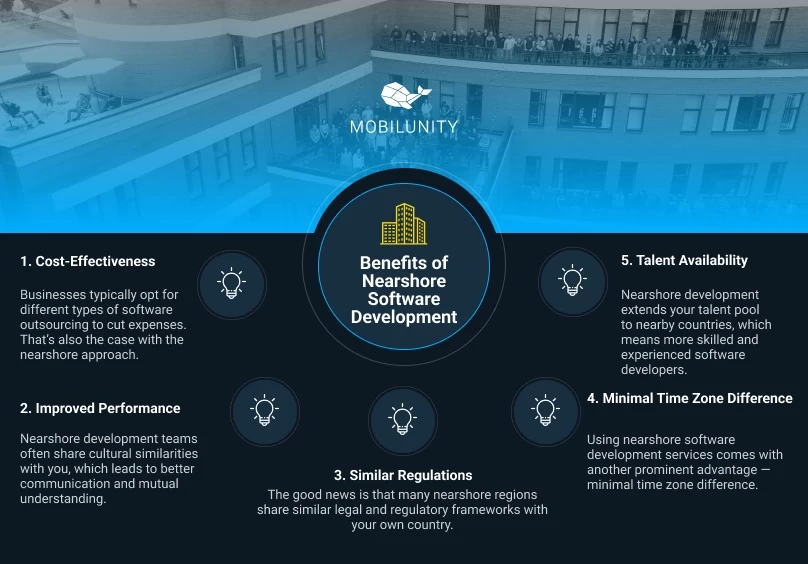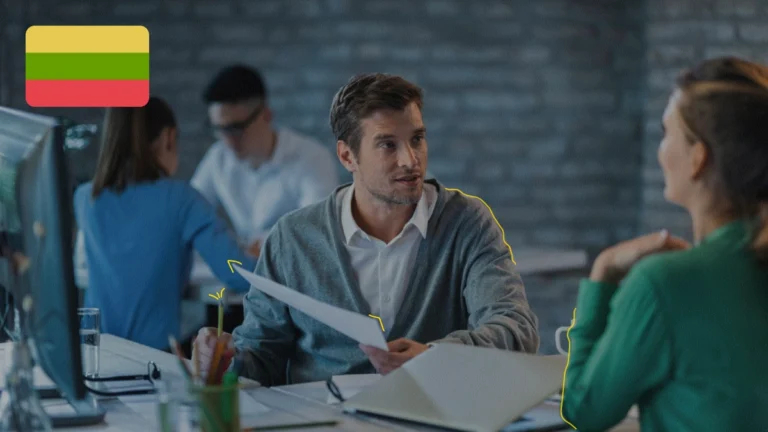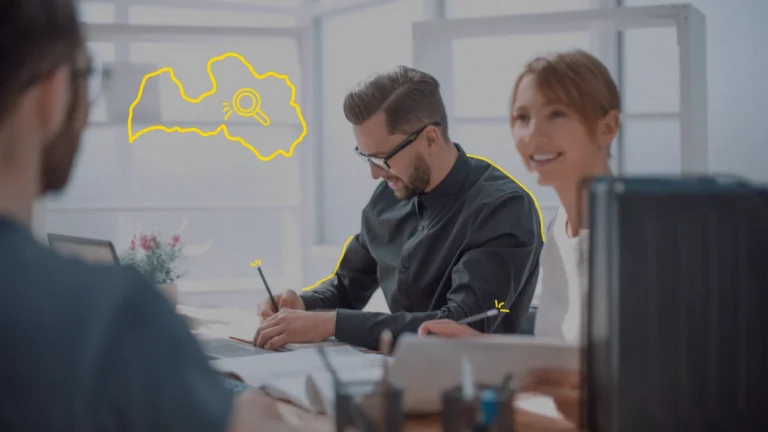What Is Nearshore Software Development: A Complete Guide
- What Is Nearshore Software Development?
- How Does the Nearshore Model Work?
- Benefits of Nearshore Software Development
- Top Nearshore Software Development Destinations in Europe
- Cost Comparison of Nearshore vs. Other Models
- Best Nearshore Software Examples
- Best Practices to Outsource to a Nearshore Software Development Company
- Mobilunity — Your Trusted Partner for Nearshore Software Development
- Frequently Asked Questions
Did you know that 79% of businesses outsource software development?
This trend is driven by a mix of cost-saving measures, evolving business strategies, and shifting operating models. Yet, outsourcing comes with a significant challenge — cybersecurity — with less than half of businesses ready to handle it.
What if there’s a better way? Consider nearshore software development, an approach that offers numerous advantages over traditional outsourcing.
In this article, we’ll discuss these very benefits, clarify the nearshoring definition, explore how it works, and explain why it might be the best choice for your software development needs.
What Is Nearshore Software Development?
Nearshore software development is an outsourcing model where you partner with a team located in a nearby country with minimal (1–3 hours) to no time zone difference. Unlike offshore software development, which involves teams in distant countries with significant time zone gaps and potential cultural barriers, this approach provides more effective collaboration. Compared to the onshore model, where your team is in the same country, nearshore outsourcing is typically a more cost-effective alternative.
Here’s a simple example. Let’s say you’re a company from the US. With nearshore outsourcing, you might hire a team in Latin America. This means you get software engineers who share or at least know your language, are relatively close to you geographically, and even have some cultural similarities to your in-house workers. Ultimately, you strike a balance between convenience and clear communication (possible with onshore development) and cost-effectiveness (often found in offshore product development models).
How Does the Nearshore Model Work?
Initiating and managing a software development project on a nearshore basis involves the following key steps:
- Initial consultation. You discuss your project requirements, budget, timelines, and desired team structure with a potential partner.
- Team setup. Following your project needs, a nearshore software development partner assembles a suitable team for you.
- Project management. Your nearshore team starts working following the selected project management methodology (Agile, Scrum, and so on). You receive regular progress reports to stay informed.
- Ongoing communication. The proximity of your and your team’s countries lets you communicate easily, often in real time. You keep working on your project, introducing various updates and improvements.
Such a simple, yet well-thought-out process allows for a strong collaboration and a profound understanding of your project goals. As a result, this approach offers faster turnaround times, high-quality deliverables, and a satisfied client — you.
Benefits of Nearshore Software Development
Nearshoring lets businesses achieve a balance between cost, quality, and efficiency. Let’s look at the advantages of nearshore software development that make this model so attractive.
Cost-Effectiveness
Businesses typically opt for different types of software outsourcing to cut expenses. That’s also the case with the nearshore approach. Compared to onshore alternatives, nearshoring offers significant cost savings. First of all, you benefit from lower labor costs. Secondly, you don’t need to deal with infrastructure investments. Plus, you reduce travel expenses for project meetings owing to geographical proximity.
Improved Performance
Nearshore development teams often share cultural similarities with you, which leads to better communication and mutual understanding. This ensures everyone is on the same page throughout the development process, resulting in fewer delays and rework. Ultimately, you achieve a smoother workflow and improved overall project performance.
Similar Regulations
When developing an application or any other custom software, you’ll have to deal with various local regulations. The good news is that many nearshore regions share similar legal and regulatory frameworks with your own country. This makes compliance easier for projects, reduces legal barriers, and streamlines data security and intellectual property rights management.
Minimal Time Zone Difference
Using nearshore software development services comes with another prominent advantage — minimal time zone difference. Now, you don’t have to wait hours or even a full day for a response from your development team. Instead, you can communicate in real time. Overlapping working hours lets you hold meetings easily, solve any issues quickly, and reach project deadlines right on time.
Talent Availability
Nearshore development extends your talent pool to nearby countries, which means more skilled and experienced software developers at your disposal. This lets you quickly gather a team that perfectly matches your specific project requirements. Additional advantages include shorter hiring cycles and the flexibility to scale your team up or down following your project needs.
Top Nearshore Software Development Destinations in Europe
Europe offers various nearshore outsourcing hubs, each with unique strengths and specializations. Let’s explore some of the top locations famous for their thriving tech ecosystems and skilled talent pools.
Estonia is one of the EU’s most digitally advanced countries, ranking 6th out of 33 countries in digital public services, according to the OECD. The Digital Economy and Society Index also shows that this Baltic nation scores above the EU average in such indicators as digital technology integration and digital public services. Just think: nearly 90% of internet users there have access to e-government solutions.
Besides that, Estonia’s robust IT education system contributes to the emergence of a significant number of tech startups. The country is home to 1,530 startups, as per Startup Estonia.
According to Statista, Poland was considered a top nearshore and offshore center for software development in 2021. The time has passed, but nothing has changed. The country currently offers a large talent pool of over 313,500 highly skilled ICT professionals.
Poland’s educational system strongly focuses on IT, ensuring a steady stream of qualified graduates. Its strategic location in Central Europe and cultural proximity to Western European countries make it a compelling destination.
Although not the most cost-effective option, Norway is an ideal nearshore destination for several reasons. Firstly, it has seen the largest growth in VC investment in Europe, with an increase of nearly 200% over the past five years. It’s also one of the top 10 European countries by VC investment.
The second reason is, of course, the cultural proximity to Western European countries and decent knowledge of English. According to the EF English Proficiency Index, Norway ranks 5th out of 113 countries boasting a very high English proficiency level. Ultimately, Norwegian developers are a perfect fit for projects in energy, maritime, and telecommunications.
Selecting a nearshore development partner from Hungary is lucrative due to the country’s competitive cost structures and well-educated IT workforce. Besides that, Hungary has a vibrant startup ecosystem, particularly in its capital, Budapest. As per StartupBlink, Budapest hosts over 228 startups, which constitute 74% of all startups in Hungary.
Germany is an indisputable industrial leader in Europe, especially in the automotive and manufacturing sectors. According to Deloitte, the country’s technology field encompasses over 100,000 companies, provides more than one million jobs, and generates sales revenues exceeding 230 billion euros (nearly 7% of Germany’s economic output). With its skilled workforce and robust industrial base, it is an ideal nearshoring location.
Ukraine provides an extensive and highly skilled tech workforce, with over 240,000 IT professionals as of 2024. The country ranks 1st in Europe for the number of tech graduates, proficient in various programming languages and technologies. Hiring development teams in countries like this proves cost-effective, making Ukrainian developers a popular choice for businesses seeking high-quality development.
Cost Comparison of Nearshore vs. Other Models
Cost is one of the most important considerations when choosing an outsourcing model. Here’s how the nearshore approach compares to other options:
- Nearshore vs. onshore. The nearshore software development model offers significant cost savings compared to onshoring. That’s because you delegate development work to a neighboring country with lower salary rates.
- Nearshore vs. offshore. While generally more expensive than some offshore destinations, the nearshore model provides decent value for the money. Plus, you don’t have to deal with huge time zone differences and cultural barriers.
So, what price to expect for each outsourcing model? Here’s a table that illustrates the average hourly rates for various IT specialists:
| Specialist | Onshore | Nearshore | Offshore |
| Project manager | $60–$120 | $50–$100 | $40–$80 |
| Business analyst | $50–$100 | $40–$80 | $30–$60 |
| Software architect | $75–$150 | $65–$130 | $55–$110 |
| Front-end developer | $50–$100 | $40–$80 | $30–$60 |
| Back-end developer | $60–$120 | $50–$100 | $40–$80 |
| UI/UX designer | $50–$100 | $40–$80 | $30–$60 |
| QA engineer | $45–$90 | $35–$70 | $25–$50 |
| DevOps | $75–$150 | $65–$130 | $55–$110 |
Working with nearshore software development teams offers a middle ground in terms of cost. It benefits you by reducing travel expenses and tackling operational inefficiencies due to similar time zones — something that’s hardly achievable with offshoring. Compared to onshore outsourcing, which provides the most physical proximity and cultural alignment, the nearshore approach is still more cost-effective. And if you’re lured by the significant cost savings of the offshore model — remember that you may face hidden costs due to challenges in management, communication, and time zone differences.
Best Nearshore Software Examples
Numerous popular software applications you may be using these days have appeared thanks to nearshore outsourcing. Let’s look at the success stories of companies that leveraged nearshore development to cut costs, hire top talent, and deliver top-notch products to their users.
Skype
During its early development stages, Skype, the popular video communication platform, benefited from nearshore developers in Estonia. The Estonian team was responsible for building the backend and the website. One of Skype’s investors, Steve Jurvetson, was so amazed by the quality of the development services that he remarked, “I remember wondering: how can they be so good?” That’s the power of nearshore development.
Slack
Slack, the SaaS communication and collaboration platform, is another example of nearshore development in action. The company’s founder decided to delegate app development to the Canadian design agency MetaLab. As a result, MetaLab assisted Slack in creating its user interface, logo, branding, and website, and developed key features like channels, direct messages, and notifications.
Wise
Wise, formerly known as TransferWise, is an international online money transfer service headquartered in London. The company leveraged nearshore development teams from Estonia and Lithuania to get their product built and ensure ongoing support and maintenance.
Basecamp
The project management software, Basecamp, has effectively used nearshore teams to support and improve certain aspects of its platform. The company opted for remote teams from Central and Eastern Europe, specifically from countries like Poland.
Best Practices to Outsource to a Nearshore Software Development Company
When looking for a team of nearshore software developers, it’s important to follow some proven best practices along the way. That’s how you ensure a good hire and maximize your project’s efficiency. Here are the aspects to pay attention to:
Expertise Relevance
If you want to choose a nearshore software team that suits your needs best, evaluating their expertise and experience is a must. Prioritize specialists with skills relevant to your project — think programming languages, frameworks, and other tools. Check if they have delivered solutions in your industry as well, as this will help you locate developers who understand your specific industry requirements.
Communication Approach
Since software development outsourcing involves mostly remote collaboration, you should ensure effective communication with your nearshore team. That’s why establish clear communication channels and set expectations early on. Decide on the video conferencing tools (Zoom, Skype, Google Meet) and any convenient project management and messaging platforms (Asana, Trello, Slack) you’ll use.
Cultural Compatibility
To determine if your vendor for software development is the right choice, ensure their working styles and values align with yours. Besides that, look for teams willing to adapt to your internal procedures. As a result, you’ll minimize misunderstandings and build stronger collaboration during the dev process.
Reputation and Trustworthiness
Partner with a nearshore development team that has a proven track record of success. Look for outsourcing companies that comply with industry regulations (ISO/IEC 27001, GDPR, and so on) and have relevant certifications and awards. Research online reviews and client testimonials to get a sense of your potential partner’s capabilities.
Cost and Value Proposition Transparency
Ensure clear and upfront communication regarding costs. Discuss not just the custom software development fees but also potential ongoing maintenance expenses. It’s also important to study the overall nearshore market and the services and rates offered by different companies. Ultimately, partner with developers that deliver the best value for the money you pay.
Mobilunity — Your Trusted Partner for Nearshore Software Development
Mobilunity is a leading provider of nearshore software development services with over 10 years of experience. During this time, we helped more than 50 clients build reliable dev teams that deliver high-quality software solutions.
At Mobilunity, we follow the three core principles: Relationships, Recruitment, and Retention. By building strong relationships, we foster trust and collaboration with our clients. Through strategic recruitment, we always find the right talent. And our focus on retention means we do everything to maintain a stable and motivated workforce.
When working with us, you will receive a range of comprehensive services. In particular, our company offers dedicated development teams with full-time resources managed entirely by you. If you opt for our consultancy services, you’ll get part-time developers under your control. Finally, our recruiting-as-a-service allows you to completely delegate the recruitment process to us.
By choosing Mobilunity, you surely get the following perks:
- Cost efficiency. The services we deliver come at a fair price — and always at an excellent quality.
- Faster time to market. We’ll assemble a suitable team for you as soon as possible and onboard it so you can initiate and complete your project quickly.
- Access to a vast talent pool. Mobilunity has access to a large talent pool worldwide, allowing you to find the perfect fit for your project needs.
- Strong project management. We fully cover HR, accounting, and helpdesk matters while you enjoy direct management of your team.
- Scalable teams. With us, you can scale your development team as your project demands grow.
Many of our clients have already experienced the benefits of the cooperation described above. Here’s just one of our nearshore software outsourcing projects. Our Swiss partner, ensurance, required a team of dedicated developers to fix and maintain their existing code. We located the necessary experts in Kyiv within weeks, ultimately establishing a strong collaboration with our client.
On top of finding suitable programmers for our clients’ projects, we constantly develop professionally. We accept new challenges, follow the latest industry standards, and seek one-of-a-kind solutions, pushing the boundaries of what’s possible in software development.
So, why nearshore with Mobilunity? Let’s recap:
- Proven 10+ years of nearshoring expertise.
- Focus on relationships, recruitment, and retention.
- Flexible and cost-effective cooperation models.
- Access to a global talent pool.
- Reliable, easy-to-scale teams.
Frequently Asked Questions
What does software development nearshore mean?
Nearshore software development is an outsourcing approach that involves delegating tasks to a team in a geographically close country, typically with a 1 to 3-hour time zone difference. This cooperation model allows for real-time communication and cultural compatibility, which is hardly possible with traditional offshore outsourcing.
What is the difference between nearshore and offshore software development?
Offshore development involves hiring teams from distant countries where time zone and cultural differences are significant. Nearshore outsourcing, on the other hand, offers a balance: similar time zones and cultural affinities while still providing cost benefits.
Is outsourcing limited to nearshore software development?
No, it isn’t. Outsourcing comprises different types of cooperation models. Those include offshore, nearshore, and onshore development. Each approach has its strengths, like cost-effectiveness (offshore and nearshore), cultural proximity (nearshore and onshore), and time zone similarity (nearshore and onshore).
Why choose nearshore?
Near shore development combines the benefits of all outsourcing approaches. It offers significant cost savings, efficient communication, improved performance, and access to a large talent pool. Generally, it lets you get expertise you may lack in your country for a good value.
What are the pros and cons of nearshore development?
The pros of nearshoring software development include cost-effectiveness, improved communication and collaboration, cultural alignment, faster time-to-market, and access to a wider talent pool. The cons are a possible lack of English proficiency and potential intellectual property concerns.
How to select the right nearshore development company?
Consider five critical factors. They are the company’s expertise, communication approach, cultural compatibility, cost structure, and overall reputation.
What to consider when gathering a nearshore dev team?
First, think about the team composition and expertise necessary for your project (web, mobile developers, and so on). Then, evaluate the team’s technical skills, industry knowledge, experience with similar projects, communication style, and ability to adapt to your project management methodologies.
How does nearshore software development contribute to business scalability and flexibility?
Nearshore partnerships offer a readily available talent pool to scale your development team up or down as necessary. This means you can be flexible and adapt to changing market or project needs.
Disclaimer: All salaries and prices mentioned within the article are approximate numbers based on the research done by our in-house Marketing Research Team. Please use these numbers as a reference for comparison only. Feel free to use the contact form to inquire on the specific cost of the talent according to your vacancy requirements and chosen model of engagement.

















